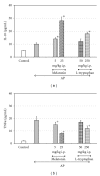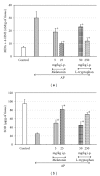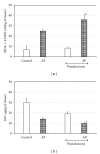Protective effect of melatonin on acute pancreatitis
- PMID: 22606640
- PMCID: PMC3347751
- DOI: 10.1155/2012/173675
Protective effect of melatonin on acute pancreatitis
Abstract
Melatonin, a product of the pineal gland, is released from the gut mucosa in response to food ingestion. Specific receptors for melatonin have been detected in many gastrointestinal tissues including the pancreas. Melatonin as well as its precursor, L-tryptophan, attenuates the severity of acute pancreatitis and protects the pancreatic tissue from the damage caused by acute inflammation. The beneficial effect of melatonin on acute pancreatitis, which has been reported in many experimental studies and supported by clinical observations, is related to: (1) enhancement of antioxidant defense of the pancreatic tissue, through direct scavenging of toxic radical oxygen (ROS) and nitrogen (RNS) species, (2) preservation of the activity of antioxidant enzymes; such as superoxide dismutase (SOD), catalase (CAT), or glutathione peroxidase (GPx), (3) the decline of pro-inflammatory cytokine tumor necrosis α (TNFα) production, accompanied by stimulation of an anti-inflammatory IL-10, (4) improvement of pancreatic blood flow and decrease of neutrophil infiltration, (5) reduction of apoptosis and necrosis in the inflamed pancreatic tissue, (6) increased production of chaperon protein (HSP60), and (7) promotion of regenerative process in the pancreas. Conclusion. Endogenous melatonin produced from L-tryptophan could be one of the native mechanisms protecting the pancreas from acute damage and accelerating regeneration of this gland. The beneficial effects of melatonin shown in experimental studies suggest that melatonin ought to be employed in the clinical trials as a supportive therapy in acute pancreatitis and could be used in people at high risk for acute pancreatitis to prevent the development of pancreatic inflammation.
Figures




Similar articles
-
The role of melatonin in pancreatic protection: could melatonin be used in the treatment of acute pancreatitis?Curr Pharm Des. 2014;20(30):4834-40. doi: 10.2174/1381612819666131119105019. Curr Pharm Des. 2014. PMID: 24251674 Review.
-
Protective effect of melatonin and its precursor L-tryptophan on acute pancreatitis induced by caerulein overstimulation or ischemia/reperfusion.J Pineal Res. 2003 Jan;34(1):40-52. doi: 10.1034/j.1600-079x.2003.02937.x. J Pineal Res. 2003. PMID: 12485371
-
Melatonin precursor; L-tryptophan protects the pancreas from development of acute pancreatitis through the central site of action.J Physiol Pharmacol. 2004 Mar;55(1 Pt 2):239-54. J Physiol Pharmacol. 2004. PMID: 15082881
-
Ghrelin and melatonin in the regulation of pancreatic exocrine secretion and maintaining of integrity.J Physiol Pharmacol. 2006 Nov;57 Suppl 5:83-96. J Physiol Pharmacol. 2006. PMID: 17218761 Review.
-
Ultrastructural clues for the protective effect of melatonin against oxidative damage in cerulein-induced pancreatitis.J Pineal Res. 2006 Jan;40(1):92-7. doi: 10.1111/j.1600-079X.2005.00288.x. J Pineal Res. 2006. PMID: 16313504
Cited by
-
Melatonin alleviates lung injury in H1N1-infected mice by mast cell inactivation and cytokine storm suppression.PLoS Pathog. 2023 May 18;19(5):e1011406. doi: 10.1371/journal.ppat.1011406. eCollection 2023 May. PLoS Pathog. 2023. PMID: 37200384 Free PMC article.
-
Melatonin as a Potential Multitherapeutic Agent.J Pers Med. 2021 Apr 6;11(4):274. doi: 10.3390/jpm11040274. J Pers Med. 2021. PMID: 33917344 Free PMC article. Review.
-
A Phase II, Randomized, Double-Blind, Placebo Controlled, Dose-Response Trial of the Melatonin Effect on the Pain Threshold of Healthy Subjects.PLoS One. 2013 Oct 2;8(10):e74107. doi: 10.1371/journal.pone.0074107. eCollection 2013. PLoS One. 2013. PMID: 25947930 Free PMC article. Clinical Trial.
-
Chemopreventive effects of resveratrol in a rat model of cerulein-induced acute pancreatitis.Mol Cell Biochem. 2014 Feb;387(1-2):217-25. doi: 10.1007/s11010-013-1887-0. Epub 2013 Nov 15. Mol Cell Biochem. 2014. PMID: 24234420
-
Protective effects of sivelestat in a caerulein-induced rat acute pancreatitis model.Inflammation. 2013 Dec;36(6):1348-56. doi: 10.1007/s10753-013-9674-3. Inflammation. 2013. PMID: 23794035
References
-
- Lerner AB, Case JD, Takahashi Y, Lee TH, Mori W. Isolation of melatonin, the pineal gland factor that lightens melanocytes. Journal of the American Chemical Society. 1958;80(10):p. 2587.
-
- Berra B, Rizzo AM. Melatonin: circadian rhythm regulator, chronobiotic, antioxidant and beyond. Clinics in Dermatology. 2009;27(2):202–209. - PubMed
-
- Esteban S, Garau C, Aparicio S, et al. Chronic melatonin treatment and its precursor L-tryptophan improve the monoaminergic neurotransmission and related behavior in the aged rat brain. Journal of Pineal Research. 2010;48(2):170–177. - PubMed
-
- Zawilska JB, Skene DJ, Arendt J. Physiology and pharmacology of melatonin in relation to biological rhythms. Pharmacological Reports. 2009;61(3):383–410. - PubMed
-
- Bubenik GA. Thirty four years since the discovery of gastrointestinal melatonin. Journal of Physiology and Pharmacology. 2008;59(2, supplement):33–51. - PubMed
LinkOut - more resources
Full Text Sources
Research Materials
Miscellaneous

